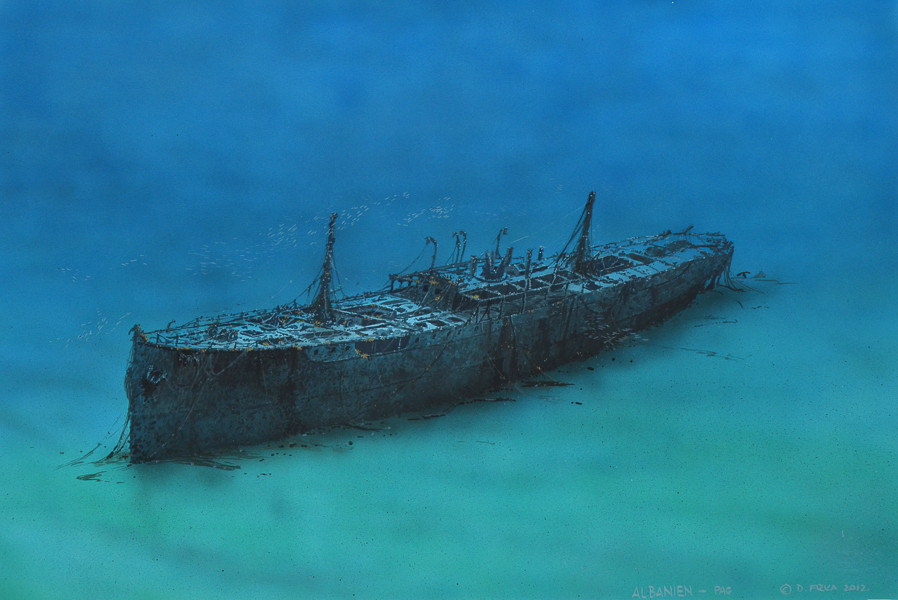
ALBANIEN
DEPTH: 60 - 70 m
SKILL: Expert
Albanien; steamship; Austro-Hungary, Österreichischer Lloyd Company
Built: Trieste 1910
Sunk: 4th June 1916 (torpedoed by Italian submarine Atropo)
Dimensions: l=65.85 m, w=9.67 m, h=4.79 m
Coordinates: 44.62908° N, 14.74950° E
Location: west of Jakišnica on Pag
Access: 2/5 access is solely by boat (the location is in the open sea)
Visibility: 3/5 variable, occasionally very good visibility
Current: 4/5 weak, only occasionally moderate
Flora and fauna: 5/5 varied life on and around the wreck, on the wreck large specimens of fish
HISTORY:
The steamship Albanien was built in the Trieste shipyard in 1910 as a modern iron ship for the transport of cargo and passengers. At the beginning of the war it was leased from the merchant navy for the local transport of military material along the Adriatic coast, where it sailed until 1916. Sailing was mostly carried out under the cover of night, so as to protect the ships from enemy reconnaissance aircraft and submarines. At that time, Italian submarines often set up ambushes in the places where the Austro-Hungarian ships had to pass, and one such place was along the west coast of the island of Pag, where the ships had to pass by on their way from Trieste towards the Dalmatian ports and vice versa. On the night of 3rd-4th June 1916 the Italian submarine the Atropo above water slowly approached the coast of Pag west of the cove of Jakišnica, in order to set up an ambush for Austro-Hungarian ships. The submarine rested on the surface, and sentries in the conning tower patiently watched the dark horizon with binoculars.
Before daybreak on the horizon there appeared a cloud of smoke, and shortly afterwards a dark blotch that looked like a steamship could be discerned with the naked eye. It was the steamship Albanien on the way to Zelenika, a harbour in the Bay of Kotor with a cargo of hay. The torpedo tube hatches were opened so as to be flooded with water and when the steamship came closer to within a distance of 400 metres, the torpedoes were fired. At exactly 0545 hrs. two explosions reverberated, both at the stern of the ship. The steamship Albanien stopped and began to increasingly sink at the stern, while the crew began to abandon the ship. It was not long before the Albanien submerged stern first and then disappeared from the surface.
It was the first successful torpedoing of an enemy ship by Italian submarines in the First World War.
WRECK CONDITION AND DIVING:
The wreck lies upright on the sandy seabed at the depth of 70 metres. The main deck is at a depth of 60 metres and is in quite good condition, except for the stern which is crushed and is a mass of twisted parts of panelling and steel beams. On the deck there is a thick layer of sand and silt, and there can be seen many openings which lead below decks. The opening to the rear cargo hold is still visible, as are several smaller vertical entrances which are mostly obstructed with various objects. At the fore section is the opening with a staircase which leads to the passenger cabins. The aft and fore masts are still in place, but are missing their upper parts. Below the stern, which apart from the damage sustained from the torpedo and the damage of the impact with the seabed, can be seen the rudder which is turned pressed alongside the propeller, which is partially buried in the sand.
From the right side of the stern can be seen the large hole created by the explosion of the torpedo and through it the rear cargo hold can be entered the lower part of which is covered in a thick layer of silt. Through the rear cargo hold the below decks can be reached, but the way further is not possible so it is necessary to return through the open stern cargo hold or through the torpedo’s hole. The passages along both flanks of the superstructure are full of dead crustaceans and so swimming through them is risky, since they can easily damage or puncture dry diving suits.
Through one or two quadrangular openings on both sides of the bow section of the hull it is possible to enter into what was once the passenger cabins. This space is constricted in places due to the various objects which had fallen from the deck above, so maximum caution is needed. Two passages lead towards the stern along the side of the ship, however one is completely obstructed with objects, whilst the other is narrow and it can be passed along.
The exact spot of the sinking of the ship Albanien was confirmed by Italian technical divers in 1998 and 1999 during the search for ships sunk during the Second World War. The investigation and protection of the wreck began in 2000, in collaboration with the Ministry of Culture of the Republic of Croatia. The Croatian Conservation Institute continued the research from 2004 until 2006 when the wreck was drawn and reviewed. Samples of the ship’s utensils and a small bell were found and removed and are now situated in a museum in Rijeka. Today the sunken ship is protected as a cultural asset and given the depth of this wreck it is available only to technical divers.
The description and illustrations are a courtesy of Danijel Frka and Jasen Mesić. Buy the whole book here: https://shop.naklada-val.hr/product_info.php?products_id=561
Built: Trieste 1910
Sunk: 4th June 1916 (torpedoed by Italian submarine Atropo)
Dimensions: l=65.85 m, w=9.67 m, h=4.79 m
Coordinates: 44.62908° N, 14.74950° E
Location: west of Jakišnica on Pag
Access: 2/5 access is solely by boat (the location is in the open sea)
Visibility: 3/5 variable, occasionally very good visibility
Current: 4/5 weak, only occasionally moderate
Flora and fauna: 5/5 varied life on and around the wreck, on the wreck large specimens of fish
HISTORY:
The steamship Albanien was built in the Trieste shipyard in 1910 as a modern iron ship for the transport of cargo and passengers. At the beginning of the war it was leased from the merchant navy for the local transport of military material along the Adriatic coast, where it sailed until 1916. Sailing was mostly carried out under the cover of night, so as to protect the ships from enemy reconnaissance aircraft and submarines. At that time, Italian submarines often set up ambushes in the places where the Austro-Hungarian ships had to pass, and one such place was along the west coast of the island of Pag, where the ships had to pass by on their way from Trieste towards the Dalmatian ports and vice versa. On the night of 3rd-4th June 1916 the Italian submarine the Atropo above water slowly approached the coast of Pag west of the cove of Jakišnica, in order to set up an ambush for Austro-Hungarian ships. The submarine rested on the surface, and sentries in the conning tower patiently watched the dark horizon with binoculars.
Before daybreak on the horizon there appeared a cloud of smoke, and shortly afterwards a dark blotch that looked like a steamship could be discerned with the naked eye. It was the steamship Albanien on the way to Zelenika, a harbour in the Bay of Kotor with a cargo of hay. The torpedo tube hatches were opened so as to be flooded with water and when the steamship came closer to within a distance of 400 metres, the torpedoes were fired. At exactly 0545 hrs. two explosions reverberated, both at the stern of the ship. The steamship Albanien stopped and began to increasingly sink at the stern, while the crew began to abandon the ship. It was not long before the Albanien submerged stern first and then disappeared from the surface.
It was the first successful torpedoing of an enemy ship by Italian submarines in the First World War.
WRECK CONDITION AND DIVING:
The wreck lies upright on the sandy seabed at the depth of 70 metres. The main deck is at a depth of 60 metres and is in quite good condition, except for the stern which is crushed and is a mass of twisted parts of panelling and steel beams. On the deck there is a thick layer of sand and silt, and there can be seen many openings which lead below decks. The opening to the rear cargo hold is still visible, as are several smaller vertical entrances which are mostly obstructed with various objects. At the fore section is the opening with a staircase which leads to the passenger cabins. The aft and fore masts are still in place, but are missing their upper parts. Below the stern, which apart from the damage sustained from the torpedo and the damage of the impact with the seabed, can be seen the rudder which is turned pressed alongside the propeller, which is partially buried in the sand.
From the right side of the stern can be seen the large hole created by the explosion of the torpedo and through it the rear cargo hold can be entered the lower part of which is covered in a thick layer of silt. Through the rear cargo hold the below decks can be reached, but the way further is not possible so it is necessary to return through the open stern cargo hold or through the torpedo’s hole. The passages along both flanks of the superstructure are full of dead crustaceans and so swimming through them is risky, since they can easily damage or puncture dry diving suits.
Through one or two quadrangular openings on both sides of the bow section of the hull it is possible to enter into what was once the passenger cabins. This space is constricted in places due to the various objects which had fallen from the deck above, so maximum caution is needed. Two passages lead towards the stern along the side of the ship, however one is completely obstructed with objects, whilst the other is narrow and it can be passed along.
The exact spot of the sinking of the ship Albanien was confirmed by Italian technical divers in 1998 and 1999 during the search for ships sunk during the Second World War. The investigation and protection of the wreck began in 2000, in collaboration with the Ministry of Culture of the Republic of Croatia. The Croatian Conservation Institute continued the research from 2004 until 2006 when the wreck was drawn and reviewed. Samples of the ship’s utensils and a small bell were found and removed and are now situated in a museum in Rijeka. Today the sunken ship is protected as a cultural asset and given the depth of this wreck it is available only to technical divers.
The description and illustrations are a courtesy of Danijel Frka and Jasen Mesić. Buy the whole book here: https://shop.naklada-val.hr/product_info.php?products_id=561








 The investment is co-financed by the Republic of Slovenia and the European Union from the European Regional Development Fund.
The investment is co-financed by the Republic of Slovenia and the European Union from the European Regional Development Fund.  H2O Globe BETA
H2O Globe BETA